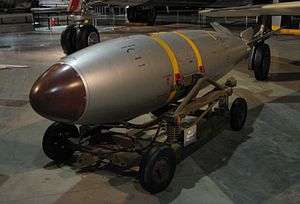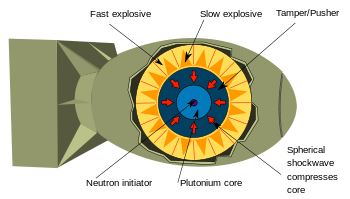Mark 7 nuclear bomb

Mark 7 "Thor" (or Mk-7'[1]) was the first tactical fission bomb adopted by US armed forces. It was also the first weapon to be delivered using the toss method with the help of the low-altitude bombing system (LABS). The weapon was tested in Operation Buster-Jangle. To facilitate external carry by fighter-bomber aircraft, Mark 7 was fitted with retractable stabilizer fins. The Mark 7 warhead (W7) also formed the basis of the 30.5 inches (775 mm) BOAR rocket, the Mark 90 Betty nuclear depth charge, MGR-1 Honest John rocket, and MGM-5 Corporal ballistic missile. It was also supplied for delivery by Royal Air Force Canberra aircraft assigned to NATO in Germany under the command of SACEUR. This was done under the auspices of Project E - an agreement between the USA and the UK on the RAF carriage of US nuclear weapons. In UK use it was designated 1,650 lb. H.E. M.C.[2] The Mark 7 was in service from 1952 to 1967(8) with 1700-1800 having been built.[3]
Bomb construction
The Mark 7 nuclear weapon weighed approximately 1,600 pounds (730 kg).[4] It was fitted with one vertical retractable stabilizer fin that allowed it to fit better in or under some planes.[1] This was unique and one of the first nuclear weapons to be streamlined enough to be carried on smaller planes.[5] The bomb’s diameter is a total of 30 inches (760 mm).[4] It used a 92-point HE detonation system to initiate implosion and nuclear fission.[3]
Detonation system
Mark 7 was a dial-a-yield capsule-type weapon with fissile (or fissionable) elements (uranium 235) stored in a separate container. This bomb used a 92 lens implosion system.[3] This means that the Uranium 235 would be compressed into critical mass by a combination of fast and slow explosions. The High Explosives shell was around 5 inches (130 mm) thick.[4] These would ensure an even compression of the Plutonium core which would cause the core to go critical and then detonate. This is illustrated in the adjacent image.[6] The missile could then detonate above the target called “Airburst”, or the missile could detonate upon contact with the target.[3] The later versions of this missile used a PAL A type arming system.[3][7] This would ensure that the nuclear weapon could not be armed or fired without an access code.

Delivery system
There were 10 different types of this bomb produced, and due to this there were several different delivery systems. Often the bomb was carried on Fighter jets or other types of planes due to the low range of the weapon, such as the F-84, F-100, F-101, and the B-57 planes.[1] The Mark 7 bomb used a lateral control system, this used a combination of gyros and servos to collect data and guide the missile to its intended target. Once the flight data was calculated it would use the gyro to adjust the yaw and to stabilize the missile. The fins were used to control the flight path using pitch.[8]
Tests
Operation Teapot: This test took place in Nevada in mid-April during 1955. This test was conducted to obtain data on the substitution ratio of U-233 for “supergrade” plutonium.[4]
Survivors
A Mark 7 casing is on display in the Cold War hangar at the National Museum of the United States Air Force in Dayton, Ohio.
Specifications
- Length: 15.2 feet (4.6 m)
- Diameter: 2.5 feet (0.76 m)
- Weight: 1,680 pounds (762 kg)
- Fuzing: airburst or contact
- Yield: variable yield between 8 and 61 kilotonnes of TNT (33 and 255 TJ)
- Implosion nuclear weapon[9]
Users

- English Electric Canberra (Royal Air Force)
- Douglas F3D-2B Skyknight
- Douglas A-1 Skyraider
- Douglas A-3 Skywarrior
- Douglas A-4 Skyhawk
- Martin B-57 Canberra
- McDonnell F2H Banshee
- McDonnell F3H Demon
- McDonnell F-101 Voodoo
- North American FJ Fury
- North American B-45 Tornado
- North American F-100 Super Sabre
- Republic F-84 Thunderjet
See also
References
- 1 2 3 USAF Museum: Mk 7 nuclear bomb
- ↑ Canberra B.6 & B.(I)6. Pilot's Notes, 1958
- 1 2 3 4 5 Complete List of All U.S. Nuclear Weapons
- 1 2 3 4 New Postwar Explosives
- ↑ Nuclear Weapons
- 1 2 Nuclear Weapon Design
- ↑ Permissive Action Link
- ↑ Guided Missiles and Techniques
- ↑ FISSION WEAPONS from Department of Energy (DOE) OpenNet documents